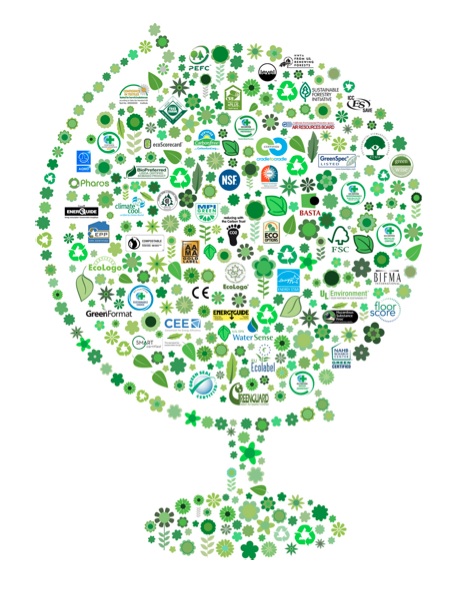Green Spec is offering people who open a trial subscription to get a free copy of the 87 page Green Product Certifications Guide. Since I am already a member, where do I find this Guide?
Blog Post
Green or Greenwash? The Quiz
Do you really know the difference between FSC and SFI? Has the federal government ended all our greenwashing woes? Find out below!
We invite you to test your knowledge with this quiz that we came up with covering key questions around when our building products are green, and when they're being greenwashed.
Stumped? We work continually to clarify questions like this with our GreenSpec product and category guidance, and through our special report on green product certifications.
-
- Greenwashing isn't something we need to worry about anymore, because the U.S. Federal Trade Commission prohibits spurious claims and requires third party certification of manufacturer claims in its "Guides for the Use of Environmental Marketing Claims."
- True
- False
- The definition of a certification is as follows, according to ISO:
- "a document, established by consensus, approved by a recognized body that provides for common and repeated use, rules, guidelines or characteristics for activities or their results..."
- "a stamp of environmental sustainability granted by Underwriters Laboratories (UL)."
- "any activity concerned with determining directly or indirectly that relevant requirements are fulfilled."
- "a statement from a manufacturer guaranteeing the sustainability of a product"
- Which is the most robust, third-party multi-attribute environmental certification available for carpeting?
- NSF-140
- Sustainable Choice
- Green Label and Green Label Plus
- A and B
- B and C
- Which of the following statements about the forestry certifications SFI (Sustainable Forestry Initiative) and FSC (Forest Stewardship Council) is true, according to a 2008 study by the Yale Program on Forestry Policy and Governance, commissioned by the U.S. Green Building Council?
- SFI and FSC mostly address the same issues
- SFI does not address social considerations--unlike FSC
- A forester may have greater latitude to pursue exceptional environmental performance under SFI
- FSC puts a premium on the preservation of old-growth stands
- All of the above
- If a product is recyclable, it means that:
- Laboratory standards are established for recovering resources from that product
- It is cost-effective to recycle the product
- The product can be recycled on any scale--small or large
- The product's content is 100% recycled
- Greenwashing isn't something we need to worry about anymore, because the U.S. Federal Trade Commission prohibits spurious claims and requires third party certification of manufacturer claims in its "Guides for the Use of Environmental Marketing Claims."
- Which of the following is a strength of multi-attribute certifications, in which a single product is evaluated under many different lenses?
- Certified products must meet a high bar for performance in many categories, not just one
- They provide consumers with a point-by-point scorecard, revealing a complete picture of environmental and social performance
- At their best, they allow consumers to quickly identify best-in-class products
- Their backing by the federal government means that more certified products are available
- Sector-specific green product certifications, like those covering wood and composites:
- Don't necessarily guarantee that a certified product is greener than its material alternatives
- Usually cover multiple attributes
- Provide key performance data for products, as well as evaluation of whether those products meet key thresholds
- Most green product certifications address toxicity in the following way:
- Most certifications don't address chemical hazards
- They include a "red list" of banned ingredients
- They require disclosure of ingredients to 1,000 parts per million
- They require reporting of hazards through Material Data Safety Sheets
- Which statement about certifications for wet-applied products like paints is NOT true?
- The historical basis for VOC (volatile organic compound) regulations has not been indoor air quality, but smog-related
- These products are commonly dealt with by restricting the quantity of total volatile organic compounds (TVOCs) in the product, as opposed to measuring the VOCs emitted from it
- The most robust guidance on wet-applied products, on which other certifications are based, is California Section 01350
- Certifications are moving to address not only product content, but interaction between products like paints and their substrates
- All of these statements are true
- In assessing the value of first-party, second-part, or third-party claims, it is most important to:
- Use first-party claims, because manufacturers understand their products best
- Always avoid second-party claims, because trade associations and consultants can be biased
- Whatever the type of certification, scrutinize the relationships and the quantifiable rigor of the program
- Always choose consensus standards that push an entire industry to better performance
- When comparing life-cycle assessment data from two similar products:
- Look for a cumulative score across many categories as the most meaningful measure
- Look to make sure that the assumptions and protocols behind the data are the same
- For projects that are certified Platinum under LEED-NC, 50% of all materials on a project must be third-party certified to environmental standards.
- True
- False
1: b. 2: c. 3: b. 4: e. 5: b. 6:c. 7: a. 8: a. 9: e. 10: c. 11: b. 12: b.
How did you do? Post your comments and questions below, and we'll respond with background on why we chose each answer
Published December 1, 2011 Permalink Citation
(2011, December 1). Green or Greenwash? The Quiz. Retrieved from https://www.buildinggreen.com/blog/green-or-greenwash-quiz
Comments
Melissa, great point and than
Melissa, great point and thanks for bringing it up in the comments here.
It's true that Sustainable Choice certifies carpeting to the NSF-140 standard. So it was a trick question in that we asked for a certification, not a standard.
We do think it's important for folks to know the difference between the two, while also understanding that Sustainable Choice and NSF-140 are closely linked.
#3 is a bit of a trick questi
#3 is a bit of a trick question.
I would argue that the correct answer is D - both NSF 140 and Sustainable Choice.
NSF 140 is the name of the standard. A product then gets certified to a standard. But in practice, people say the product has "NSF 140" meaning that the product is certified to the standard.
SCS certifies products to the NSF 140 standard and they have chosen to develop their own branded name of "Sustainable Choice," indicating compliance to the NSF 140 standard. But one of the beauties of an ANSI standard is that they are open for any certifier. In order to minimize confusion, many of us in the carpet industry simply refer to products certified to the standard as "NSF 140", versus developing a slew of unique brand names based on the certifier we choose, or the cumbersome "certified to the NSF 140 standard".
Saying "Sustainable Choice" is the same as saying "certified to NSF 140". They both indicate certification to the same standard.
I don't want readers to assume that there is a fundamental difference between Sustainable Choice and NSF 140. In your question, you are simply trying to make the point that one is the standard, NSF 140, and one is a certification to that standard, Sustainable Choice.
Thanks for letting me clarify.
Melissa Vernon
Director of Sustainable Strategy
InterfaceFLOR
Social responsibility
SFI Program: thanks for your comments--and also for identifying yourself as an official SFI commenter. That is really helpful for our readers.
I think most people take the legal bit as a given. I guess technically you could say that the standard "addresses" the issue by explicitly stating that loggers must follow the law, but that would be a little like LEED "addressing" indoor air quality by saying buildings have to meet code.
I'm curious whether there's any movement within SFI to emphasize social responsibility more in the future.
Thanks for bringing attention
Thanks for bringing attention to responsible forestry. However, the truth is that Sustainable Forestry Initiative does address social considerations and take it very seriously — we even have 1/3 of our Board of Directors represented by our Social Sector, with the remaining equally divided between environmental and economic sectors. SFI and its program participants must comply with social laws, such as those covering civil rights and indigenous peoples’ rights, among others. SFI is making a difference on the ground – educating loggers and landowners, promoting best management practices and supporting conservation groups and forest communities across North America. Read more on SFI’s social responsibility at http://www.sfiprogram.org/sustainable-forestry-initiative/social-respons... and get the facts by visiting: http://www.sfiprogram.org/facts/.
Dave, thanks for commenting a
Dave, thanks for commenting and catching our typo! The correct answer to #3, now reflected in the answer key, is B.
Regarding question #3, isn't
Regarding question #3, isn't the Green Label for carpet a Second Party label, not Third Party? It is administered by the Carpet and Rug Institute, which is an industry trade association. The CRI website states that, "Policy is determined by a board of directors composed of chief executive officers from member companies."
Lloyd, a) recyclable is defin
Lloyd, a) recyclable is defined by the FTC, as you know from reading our report, and "cost-effective" is part of their definition, and b), if Tetra Pak is recycling these pieces of trash (which became trash as soon as they came off the assembly line), then apparently they have decided it is cost-effective by some measure.
However, I agree with your overall point and I would say that this is another form of greenwash -- bending the rules to allow an approach that is narrowly "green."
10 out of 12, but I have read
10 out of 12, but I have read the book. I really disagree with your 5 answer b: "It is cost-effective to recycle the product". There are so many products out there that are not cost-effective to recycle but they are setting up recycling just to make people feel better. Two examples are Tetra-Pak and Nesspresso coffee pods, where the companies are going to great lengths to greenwash their products by setting up recycling facilities. My favourite description of tetrapak recycling:
"What does "re" mean? It means again. Can a Tetra Pak be made into another Tetra Pak? No. Tetra Paks are seven incomprehensibly thin layers of paper, plastic and aluminum. The poor suckers who try to recycle them use giant blenders to mush the paper pulp off the plastic and metal, then they need to separate the plastic from the metal. What idiot thought this would be a better idea than washing a bottle and refilling it?"
A lot of recycling isn't cost effective, it is just feel-good justification for disposables





Add new comment
To post a comment, you need to register for a BuildingGreen Basic membership (free) or login to your existing profile.